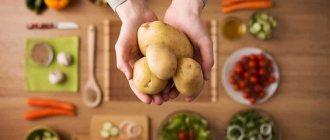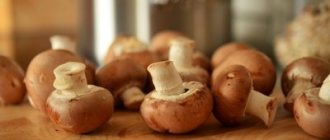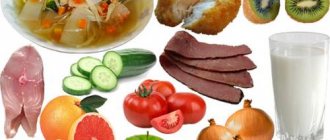| What can replace potatoes? | Description |
| Sweet potato | Sweet potatoes are called the closest relative of potatoes. Its color varies from white to deep orange. Sweet potatoes contain the same amount of beta-carotene as carrots. In French-style potatoes, it can replace the main ingredient, since it is perfect for baking, stewing, and making purees. |
| Carrot | Carrots are almost completely free of starch, which is not needed by those who are on a diet or adhere to proper nutrition. A vegetable rich in beta-carotene has a beneficial effect on the general condition of the body, improves vision, and strengthens the immune system. The presence of boiled carrots in a salad instead of potatoes can make the taste of a familiar dish more interesting. |
| Jerusalem artichoke | Jerusalem artichoke tubers are rich in fiber, which improves digestion. They can be boiled, like the potatoes themselves, added to salads, or eaten raw. If potato pancakes contain Jerusalem artichoke instead of potatoes, this will make the dish lighter and healthier. |
| Cauliflower | This vegetable is filled with numerous beneficial substances:
Cauliflower contains glucaraphanin, which prevents the development of ulcers and stomach cancer. Cauliflower makes a wonderful puree. It can be seasoned with fresh herbs and a small amount of butter. |
| Legumes | Among legumes, beans are a worthy alternative to potatoes. If you choose between red and white beans, it is better to take white ones. It would be appropriate:
Other varieties of beans are great for making purees. Many people use peas, chickpeas, lentils, and soybeans for this. |
Potatoes are a product without which it is difficult to imagine most of the dishes that are regularly present on the table of residents of many countries. This is a traditional ingredient that is added to Olivier, it is always present in the fur coat.
Excessive enthusiasm for potatoes also has a downside - the vegetable contains a lot of starch, it is too high in calories and carbohydrates. Its consumption leads to an increase in blood sugar levels.
Knowing all this, you should know what you can replace potatoes with so as not to lose your favorite tastes, but also not to harm your health.
Sweet potato
The closest vegetable to potatoes is sweet potatoes. Its second name is “sweet potato”. Due to their high beta-carotene content, the color of sweet potatoes can be bright orange, but almost all white vegetables are also found.
Sweet potato tubers contain a minimal amount of starch and a lot of fiber. They also have a low glycemic index. Sweet potatoes can be added to salads and boiled. It is suitable for baking in the oven with meat and other vegetables.
This is a good replacement for those who are on a diet and are watching their nutrition. In a vinaigrette, it can also fully replace potatoes, and the familiar taste will not suffer from this. It is better not to eat it raw.
Ground pear chips
Jerusalem artichoke is also called earthen pear, Volga turnip or Jerusalem artichoke. Although it has absolutely nothing to do with the Promised Land, as well as with the artichoke. It began to be grown by the indigenous Indians in North America. And the first settlers from Europe were so fascinated by this crunchy, sweet root with pleasant notes of nuts and sunflower seeds that they sent it home for further cultivation. And only later, in the 18th century, Jerusalem artichoke came to Russia. True, he never gained enormous popularity - we fell in love with his “compatriot” - potatoes.
But over the past few years, in the wake of the trend for a healthy lifestyle, the earthen pear has become famous throughout the world and is loved by chefs for its wide culinary possibilities: it can be served raw in salads (and thin, almost transparent slices hold their shape well), put in soups, make puree, sauté and tempura, deep-fry, bake, wok-fry and even ferment.
Since childhood, we have become accustomed to potatoes - dishes from this vegetable have long become traditional in our latitudes, although they were brought to Europe only in the 16th century. Of course, potatoes are very nutritious and high in calories, but that is why those who care about their figure should avoid them. Tubers also contain a lot of carbohydrates (about 20 grams per 100 grams of product) - this provokes an increase in blood sugar, which is not suitable for diabetics. Potatoes also contain a lot of starch, which can negatively affect digestion. So what can you replace potatoes with? What vegetables are suitable for this purpose?
Almost the same structure, but much fewer calories, almost complete absence of starch, minimum carbohydrates and maximum benefits: vitamins, microelements and antioxidants. And the main “richness” of carrots is beta-carotene, which turns into vitamin A in our body and has a beneficial effect on the visual organs, on the skin, on the immune system and even regulates blood sugar levels. Carrots can be eaten raw, unlike potatoes, and, of course, cooked in soups and broths, made into a side dish and even snacks such as oven chips.
Surely you have seen more than once bright yellow flowers almost as tall as a man. At its core, Jerusalem artichoke can be called a weed - it self-seeds and spreads over a large space without obstacles. And by planting a tuber, you will receive a stable harvest from year to year. Jerusalem artichoke contains a lot of fiber, and therefore will have a positive effect on digestion, as well as vitamins B1, B2 and C. There are also useful potassium and silicon, calcium and magnesium, sodium and manganese. You can eat it raw, adding it to salads, or boil it in the same way as potatoes.
One of the close relatives of potatoes, which is often called “sweet potatoes”. Sweet potatoes come in a variety of colors, from white to deep orange (this particular variety contains almost as much beta-carotene as carrots). Its tubers are oblong, contain a lot of fiber, have a low glycemic index and a minimum of starch. It is not recommended to eat it raw; it is better to puree it, add it to soups or bake it in the oven.
By the way, about mashed potatoes. Many people love mashed potatoes with herbs and a piece of butter. You shouldn’t deny yourself this dish, but you can make it healthier by replacing potatoes with cauliflower. By boiling it until tender and mashing it, you will get a puree that is as close to potato puree as possible in consistency and taste. But cauliflower will contain a minimum of calories and many useful substances: protein, vitamins C and PP, phosphorus and iron. There is also glucarafin, which prevents the occurrence of peptic ulcers and stomach cancer.
Carrot
The well-known carrot, which fills the body with beta-carotene, antioxidants, beneficial vitamins and microelements, can replace potatoes. Regular consumption of carrots helps regulate blood sugar levels and keep them under control - this is important for people with diabetes.
Carrots are great for eating raw. It should become an integral part of fresh salads, soups, and side dishes. In cutlets, it can replace potatoes if such a component is mandatory and cannot be avoided. Many people like to treat themselves to carrot chips - they are a delicious and healthy snack.
Few people know that regular consumption of carrots, raw and cooked, improves skin condition and helps stabilize blood pressure levels. The fiber contained in the vegetable quickly normalizes digestive processes and eliminates periodic discomfort.
Turnips and turnips
This unpretentious garden crop in Rus' was used for food long before potatoes appeared in the garden beds (remember the expression “easier than steamed turnips”?), but today it is practically forgotten by many in favor of “second bread”. And quite undeservedly. Let's explain why.
Turnips are not nearly as starchy (and therefore not as high in calories) as potatoes - about 30 kcal per 100 g.
Turnips contain beta-carotene, vitamins A, C, PP, B1, B2, E, fiber, vegetable protein, a lot of calcium and succinic acid (a universal biostimulant). Turnip helps fight hypovitaminosis, stimulates the secretion of gastric juice, enhances intestinal motility, and improves food absorption. The juice of fresh root vegetables is also used for medicinal purposes - as a remedy with diuretic, antiseptic, anti-inflammatory, wound healing and analgesic effects.
Elongated fodder varieties of turnips are called turnips, and they are also widely used not only for livestock feed, but also in “human” cooking.
What about the taste of turnip? In boiled (steamed) form, it is indeed very similar to unleavened potatoes - if you remove the excess starch from the latter and add a subtle flavor. Spices, honey, mustard or herbs will make boiled turnips a savory snack, and butter or sour cream will make a delicious side dish. Pieces of boiled turnips will also fit in any soup and salad, and gourmets can fry them in butter. Since root vegetables contain enough essential oils, their consumption in raw form should be limited in case of inflammatory diseases of the gastrointestinal tract.
Jerusalem artichoke
Jerusalem artichoke tubers are a real storehouse of fiber that is beneficial for the body. Thanks to it, the functioning of the digestive system improves. In addition, regular consumption of Jerusalem artichoke will saturate the body with vitamins B and C. Tubers contain calcium and silicon, magnesium, and manganese.
Healthy tubers can be consumed fresh. They are used to prepare a variety of vegetable salads. Jerusalem artichoke is suitable for boiling, as it most closely resembles potatoes. It can be added raw to minced meatballs.
Swede
If we already mentioned turnips, let’s not forget its “close relative” rutabaga, which has also long been revered in Rus' as a valuable food crop and was on the tables of both the nobility and ordinary peasants.
In terms of calorie content, this product is almost twice as “cheaper” than potatoes - only about 37 kcal per 100 g. Rutabaga contains enough dietary fiber, vegetable protein, vitamins (especially C, A and group B), potassium, calcium and phosphorus. It is useful for the functioning of the intestines and heart, cleanses blood vessels, and relieves swelling. Raw rutabaga is also rich in mustard oil, which gives the root vegetable bactericidal properties, allowing its juice to be used as a medicine for colds, dry coughs, inflammations and burns.
Rutabaga is contraindicated in acute diseases of the gastrointestinal tract.
As for the taste, when boiled, stewed or baked, rutabaga really strongly resembles potatoes, allowing you to replace it in many dishes from stews and cutlets to salads and casseroles, and in its raw form, many compare it to juicy turnips (the main thing is not to let it overripe, become tough and fibrous). The root vegetable goes well with other vegetables and can act as a complete independent nutritious side dish for meat and fish.
Cauliflower
Many people cannot understand how cauliflower can replace potatoes. If you prepare the vegetable correctly and add just a little spice, which can hide the characteristic cabbage smell, then the prepared puree with fresh herbs can be mistaken for potato puree.
This option is simply a godsend for those who count calories and do not want to eat carbohydrate potatoes.
Cauliflower will be an excellent addition to soups and broths. It can be added to salads. The advantage is that it has a light, sweetish taste, but the vegetable is able to quickly absorb spices and other flavors.
Against the general background, cabbage will not stand out separately. If the cooked cauliflower puree retains the smell of the vegetable, you can add a little ghee or fresh butter to it.
How to replace potatoes
Ecology of consumption. Food and drinks: Of course, any substitutions remain substitutions, but health and a slim figure are worth it...
How delicious are potatoes! But it’s not good for everyone—it’s too high in calories, too high in carbohydrates. It quickly raises blood sugar levels, which is well known to diabetics.
A medium-sized boiled potato weighs approximately 100 grams. Contains approximately 70 cal and 15 g. carbohydrates. Not that much, right?
But when there are freshly cooked potatoes on the table, who can resist limiting themselves to just one? At least a couple - and this will already be 140-150 cal and 30-35 grams. carbohydrates. Is it a lot or a little?
Depends on what else will be on the table with the potatoes. Eating extra food can quickly increase both the calorie count and the carbohydrate count to impressive levels.
When I think about potatoes, I usually think of my grandmother Marina. She lived in a Ukrainian village and, of course, always kept a pig or two. What did she feed them? Usually it was a bucket of boiled potatoes, flavored with milk from your cow. I also added whole grain flour, and in the summer beet and corn leaves from the garden.
On such a pure and natural potato-grain diet, plump pigs grew up, literally half consisting of the famous Ukrainian lard.
But what is a pig that has a lot of lard? From a medical point of view, this is an obese pig.
Now let's remember that pigs also have milk teeth, pigs can sunbathe like people. Their organs are similar to human ones in size and physiology, which is why pig organs are used as organ donors for humans. That is, the human body is similar to the pig body, whether we like it or not.
If the potato-grain diet of pigs causes them to become obese, then the diet of people based on potatoes and grains should also cause obesity - which is what we see around us.
What can you replace potatoes with less carbohydrates and less calories? I experimented with different vegetables and came to the conclusion that it is difficult to replace potatoes with any one vegetable. Some vegetables are good substitutes for boiled potatoes, others - when fried, etc.
In an attempt to replace potatoes in my diet with some vegetable with a lower glycemic index, I tried several vegetables and came to the conclusion that “mashed potatoes” are made best from cauliflower .
Especially if you add some aromatic spices to the puree so that the cabbage smell is invisible.
Fresh butter or ghee masks the smell of cabbage very well.
“Fried potatoes” turn out very well from white turnips.
“Stewed potatoes” are made well from parsnips. It is not as juicy as turnips, and the pieces do not lose their shape when stewed.
You can replace it with parsley or celery root, but this is not for everyone - these root vegetables seem too aromatic to me.
Of course, any substitutions remain substitutions, but health and a slim figure are worth it. Published
Also interesting: Millet can replace rice and potatoes in a healthy diet
Italian baked potatoes: simple and very tasty!
PS And remember, just by changing your consumption, we are changing the world together! © econet
Legumes
Beans and other legumes are an excellent substitute for potatoes. It is best to add beans to soup, cabbage soup or borscht. It is better to use white varieties. You can also make puree from legumes. Dried peas are more suitable for this dish.
It can be replaced with chickpeas or lentils to taste. These same legumes are also used to prepare delicious and satisfying pureed soups.
Legumes contain vegetable protein, a minimal amount of fat, and a lot of dietary fiber. Regular consumption of legumes helps stabilize blood pressure and lower cholesterol.
There are more than enough options to replace potatoes. Each of the alternative products has a lot of advantages and is filled with useful substances. You can choose what will replace potatoes in Olivier, in fur coats or cutlets according to your taste, making the dishes healthier.
Potatoes are a universal root vegetable that is used to prepare both first and second courses. But if you want to take a little break from it or have a goal to lose weight, then you can prepare several soups without skipping this vegetable.
Pumpkin, zucchini, squash
Why are all these vegetables “together” on our list? Because both the long zucchini we are used to and the squash plates are all varieties of the common pumpkin, and their fleshy pumpkin fruits are very similar in quality. Moreover, among all these vegetables there are quite sweet types and varieties, as well as quite neutral, almost “potato” taste - suitable for soups and side dishes (they are usually distinguished by color - the more red and orange, the sweeter the pumpkin, while white and green varieties have a more neutral taste).
The calorie content of pumpkins, zucchini and squash ranges from 20 to 40 kcal per 100 g - this is still much less than that of potatoes.
The vitamin and mineral composition of these fruits is very rich and very balanced, which allows them to be used in dietary nutrition. There is an abundance of fiber and vegetable protein, about 20% starch, vitamins (A, C, D, E, F, PP, T, group B), potassium salts, calcium, magnesium, iron, pectin, useful microelements (copper, cobalt, zinc, etc.).
Zucchini is the first vegetable that is introduced into baby food for babies, because... it practically does not cause allergic reactions.
All these vegetables are perfectly absorbed by the body and even help digest other foods. They can be added to children's menus, to the diet of people suffering from digestive and cardiovascular problems or those recovering from an illness, and used in various diets for weight loss.
The big advantage of pumpkins and zucchini is their ease of growing and long shelf life.
- Simple recipes for delicious pumpkin dishes
After looking through our selection of recipes, you will definitely want to cook pumpkin! The recipes are very simple!
- What can you cook from squash quickly and tasty?
Find out what dishes can be prepared from squash and what products are best combined with them.
- What to cook with zucchini - 15 simple recipes for every day
Simple recipes for incredibly delicious dishes made from fresh zucchini.
Rice soup with beef
Required Products:
- beef – 400 g;
- rice - 8 tablespoons;
- bay leaves – 3 pieces;
- carrots – 2 pieces;
- sunflower oil – 5 tablespoons;
- onions – 2 pieces;
- table salt – 50 g.
Preparation:
- Trim excess fat from the meat and remove the veins, rinse it thoroughly and cut into pieces ranging in size from 3 to 5 centimeters.
- Place the meat in a pan and add hot water for faster cooking. Add salt and cook over low heat for about 40 minutes.
- Wash the uncooked rice thoroughly and set it aside.
- Peel the carrots, rinse them and rub them through a grater with the smallest holes.
- Peel, rinse and chop the onions.
- It’s good to heat the oil in a frying pan and put the carrots and onions in it, do not saute them, stirring.
- When the meat has cooked for the required time, add rice.
- Add the sauteed vegetables to the broth, stir and continue cooking for another half hour.
- Serve the dish by adding fresh herbs to the plates.
Soup with sorrel and egg
Ingredients:
- fresh sorrel – 450 g;
- eggs – 7 pieces;
- bay leaves - 2 pieces;
- large carrots - 1 piece;
- onion – 1 head;
- oil – 3 tablespoons;
- salt – a couple of pinches;
- spices - to taste.
Preparation:
- Peel the carrots and grate them.
- Peel the onion heads, rinse under cold water and chop into small cubes.
- Pour oil into the bottom of the frying pan and place it on the fire.
- When the oil starts to bubble, add the onions and carrots and simmer until soft.
- Wash the sorrel leaves thoroughly and chop them.
- Fill the pan with water and place it on maximum heat.
- After boiling, add stewed vegetables, sorrel, bay leaves, spices and salt.
- Cook for 10 minutes and add the beaten egg mixture.
- Stir and turn off the heat.
The dish is ready to serve.
Tomato soup
Grocery list:
- tomato juice – 2 l;
- carrots - 1 root vegetable;
- parsley – 1 bunch;
- bell pepper – 2 pieces;
- bay leaves – 3 pieces;
- ground cinnamon – 1 teaspoon;
- salt – 1 teaspoon.
How to make soup:
- Pour tomato juice into a saucepan, add salt and put on fire.
- After boiling, place the peeled and thinly sliced carrots into it.
- Add bell pepper chopped into half rings.
- Add mustard and place bay leaves in boiling juice.
- Cook everything together for another 20 minutes and at the end add a little, stir and remove from the stove.
- Pour into plates and serve, sprinkled with herbs.
Light chicken soup
List of ingredients:
- chicken fillet – 600 g;
- vermicelli – 0.5 cups;
- carrots – 2 pieces;
- dried dill – 1 tablespoon;
- onion – 1 piece;
- salt – 1 dessert spoon;
- water – 4 l.
Recipe:
- Pour water over the chicken fillet and place on the fire.
- After boiling, boil for 5 minutes, drain the water and rinse the meat.
- Place it again in a clean container, pour in 4 liters of water and let it cook.
- When the water boils, place the peeled onion in it.
- After half an hour, add the carrots, cut into half rings, and cook for another quarter of an hour.
- Remove the onion from the broth and add vermicelli.
- Cook for another 10 minutes, and then add the dill, stir, turn off the heat and let it brew for another 20 minutes.
Afterwards it can be served for lunch.
Buckwheat soup
Required Products:
- meat broth - 2 l;
- buckwheat – 150 g;
- seasoning for soup - 1 dessert spoon;
- bell pepper – 200 g;
- dill – 1/2 bunch;
- salt to taste.
Preparation:
- Pour well-washed buckwheat into boiling meat broth and cook for a quarter of an hour.
- During this time, wash, remove seeds and cut into cubes the sweet pepper.
- Rinse fresh dill and chop it finely.
- When the buckwheat has cooked for the required time, add pepper to the pan and cook for another 10 minutes.
- Lastly, add spices, herbs and, if necessary, salt into the broth.
- Let it boil for about 5 minutes and remove from the stove.
- Serve in portions with sour cream.
Meatball soup
List of ingredients:
- minced pork – 700 g;
- carrots – 200 g;
- garlic – 4 cloves;
- rice – 150 g;
- onion – 200 g;
- eggs – 2 pieces;
- parsley – 1 bunch;
- ground pepper – 1/3 teaspoon;
- butter – 50 grams;
- salt – 1 teaspoon.
Cooking process:
- Place minced meat, thoroughly washed raw rice, eggs, ground pepper, salt and very finely chopped garlic into a deep bowl.
- Knead the minced meat into a homogeneous mixture and form into small meatballs.
- Fill a saucepan with 4 liters of water, place the meatballs in it and let it cook.
- Grate the carrots and chop the onion into cubes.
- Melt a piece of butter in a frying pan and fry the onion until soft.
- After 3 minutes, add carrots and simmer for another 5 minutes.
- After the water boils, you need to carefully stir the meatballs.
- Place the vegetable sauté from the frying pan into the boiling broth and cook for half an hour.
- Pepper, salt and add chopped parsley to the dish.
- Remove from heat and let sit for a while before serving.
Verona celery root puree with three types of onions and thyme
I prepared this dish at my first master class, and it was the most discussed dish at dinner. For many, celery root puree was a revelation. Tender, creamy and light in taste, it becomes richer due to spices - garlic, aromatic onions and piquant thyme. This recipe is Italian, where the product is very popular and grown in the north of the country. By the way, celery root there is called celery from Verona.
What you need (for 4 servings):
- Celery root - 1200 g
- Onion (large) - 1 pc.
- Leek (light part) - 150 g
- Chives - 8 feathers (can be replaced with 5 regular green feathers)
- Garlic - 4 cloves
- Thyme - 4–5 sprigs
- Almond milk (can be replaced with any plant milk) - 120–150 ml
- Freshly squeezed lemon juice - 1 tsp.
- Extra virgin olive oil - 1 tbsp. l.
- Freshly ground black pepper - to taste
- Sea salt - to taste
What to do:
- Peel the celery root and onion and cut them into small cubes, cut the leek into rings, finely chop the chives and garlic.
- Pour a little oil into a large saucepan, lightly fry the leeks and onions, add salt, add thyme, simmer for one minute, add celery root, add salt again, cover and simmer until tender, stirring often, about 25-30 minutes. Three minutes before readiness, add finely chopped garlic.
- Remove the thyme sprigs, add vegetable milk, lemon juice, finely chopped chives, pepper and grind with an immersion blender until a thick and smooth puree. If desired, rub the puree through a fine sieve to catch any lumps.










